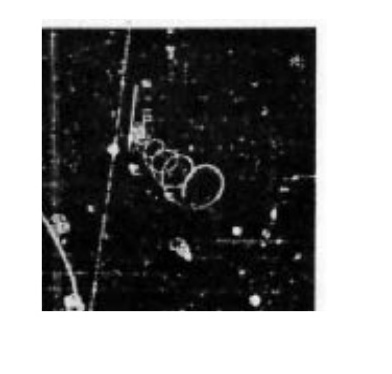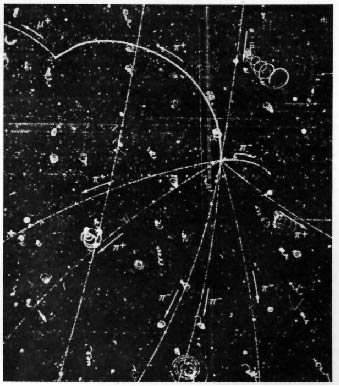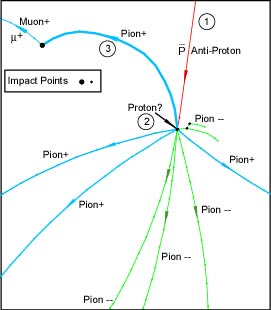-
How Physicists “Find” Their Particles!
Posted on June 25th, 2011 No commentsThis really started with ‘Brownian Motion’ and Einstein’s interpretation of it. Over the years the equipment has got more sophisticated and costly.
Note: No-one as ever seen or isolated any of the physicist’s particles, or even presented a sensible explanation of them. The cloud Chamber, the Bubble chamber and the Hadron Collider only show tracks that may be particles, atoms or molecules. there is no actual evidence of what the tracks really are.
Simplified, they fire something into a liquid or gas and see what happens. (Please understand that they don’t actually know what it is that they are firing.)
They then take photographs of what happens. The photographs require 100s of thousand of photons to produce each one. (Please understand that they do not know what a photon is. They think that it is something between a particle and a wavy line.)
The photograph below is typical of the those taken. DON’T PANIC IF IT CONFUSES YOU, ALL WILL BE SIMPLIFIED IF YOU HAVE UNDERSTOOD MY POSTS ON ‘UNDERSTANDING MECHANICS’.
This photograph is claimed to show the mutual annihilation of an Anti-proton and a Proton, and the creation of charged Pions. Again, don’t panic, because the names are meaningless.
Below is a simplified version of the above.
The Red line shows the path of an imaginary ant-Proton. This strikes a ‘supposed’ proton at 2. The Blue lines are claimed to be the tracks of positive Pions and the green lines are claimed to be the tracks of negative Pions. The heavy line at 3 is claimed to be a positive pion that finally strikes some unknown object and bounces off to become a positive Muon. (The actual statement from the physicists is that comes to rest and decays into a Muon.) Why would it change direction on becoming a Muon?
At the right hand side of the Proton? there is a negative Pion that appears to split into two negative Pions.
It may have occurred to you that all the positive Pions travel anticlockwise and the negative Pions travel clockwise. If we had a photograph taken from directly opposite the camera taking the above picture would physicists mark the above positive Pions as negative Pions, etcetera.
Now let us look at other options. Let us consider that the Proton at 2 is actually an atom. Now Pions, Muons, and all the other mythical particles are all deemed to be parts of atoms. Therefore the atom is quite massive relative to the particles.
Now if atoms are partly composed of all these other particles, then on being struck by a high speed particle, these other particles are quite likely to be dislodged or sent flying in all directions. If dislodged particles have some degree of spin, then they will travel a curved path, either clockwise or anti-clockwise, depending on the direction of spin, just like a tennis or cricket ball.
What if the tracks were caused by electrons not mythical Pions? Well, this would go against the physicists hypotheses, because they claim that hydrogen only has one electron. However, that is just an hypothesis, for there is no proof to back it up, My own hypotheses indicate that it is not true.
However, electrons could certainly fit the above photographic ‘evidence’.
Another problem with the above is relating to the energy of the particles. Line 3 is stated to be of ‘relatively low energy as gauged by the small radius of curvature of its trajectory’. The curvature is caused by the amount of spin on the particular particle. The total energy of a speeding particle is a combination of its forward speed and its rotation.
Spirals on the photograph.
In the top right hand side of the photograph there is a spiral track as shown below.
The physicists claim that these sort of tracks are caused by electrons.

I am very doubtful of this claim. A tight track such as this would indicate an unbalanced force in operation. The spiral paths are far more likely to caused by a spinning molecule. If it was a spinning electron it would have to have a very high spin rate and would not suddenly stop as shown. The type of camera used could also affect the results. Also the length of exposure of the film. As previous notes, they have really no idea what it is that they are ‘apparently’ seeing.
———–————
———————–
The photograph used in this post is quite a famous one in physics circles and is claimed as proof of many aspects of ‘particle’ physics. It is one out of millions of photographs taken in an attempt to justify the physicists hypotheses. 99.999% of the other photos do not justify the hypotheses! Its like taking a million photos in a shopping mall and finding one that shows only men, and then claiming that this proves that only men go to shopping malls. Anything can be claimed when searching through millions of photographs of purely random interactions between particles.
Matter and anti-matter particles.
Physicists constant discussions and publications relating to anti-matter particles is based on on photographic ‘evidence’ in the same way as the above photograph. If a particle is fired into the gas (or liquid) and appears (on the photograph) to suddenly disappear, there are many possible reasons for this. It could have slowed down and then stopped. It could have hit an atom and bounced off either away from or towards, the camera. It could be in orbit around an atom
—————-
Note: The Hadron Collider is just a very, very expensive version of this experiment.
———–
“Tevatron teams clash over new physics.”
All the above comments also apply to the Tevatron accelerator in the USA, currently in the news. I suspect that they are struggling to find a magic particle to enable them to keep the unit open. (It is due to close shortly.)
A LOT MORE TO COME ON THIS TOPIC.
Author;Brian Williams
General Physics, Physics in the News bubble chamber, How Physicists 'find' particles, investigating physics particles3 responses to “How Physicists “Find” Their Particles!”
-
I was curious if you ever considered changing the layout of your site? Its very well written; I love what you’ve got to say. But maybe you could a little more in the way of content so people could connect with it better. You’ve got an awful lot of text for only having 1 or two pictures. Maybe you could space it out better?
—————————–
The physics posts are excerpts from my books. They are short because most people will not read more than a few paragraphs on any technical subject. Within this short quantity of text I must arrive at the ‘core’ of the problem and propose a sensible solution.
I could, of course, expand these few paragraphs into 1,000s of pages without actually adding anything of value. (Most of modern physics is based on vast quantities of text that is not understandable by the people who pay their wages.)
In the post ‘Physics in the News’, the BBC articles only regurgitate what they have been told by the physicists, but they strip out many of the ‘big’ words that they know will only confuse people. The BBC science writers are generally part of the physics ‘establishment’ usually having degrees in physics.
The photograph used in ‘Physics in the News/ How physicists ‘find’ their particles’ is quite a famous one in physics circles and is claimed as proof of many aspects of ‘particle’ physics. It is one out of millions of photographs taken in an attempt justify the hypotheses. 99.99% of the other photos do not justify the hypotheses! Its like taking a million photos in a shopping mall and finding one that shows only men, and then claiming that this proves that only men go to shopping malls,
Brian -
Thanks for the post I actually learned something from it. Very good content on this site Always looking forward to new post.
-
I was more than happy to discover this great site.
I wanted to thank you for your time for this particularly wonderful read!!
I definitely appreciated every bit of it and i
also have you bookmarked to check out new information in your website.
Leave a reply
-



